The story of the Eucharist starts early in Exodus and keeps building through the Pentateuch. The pinnacle of this is in the Passover and the Manna, two the most significant images and signs pointing to Jesus and the Eucharist. These are the most obvious signs, but there are others. God worked to prepare us for the coming of His Son and for the ultimate gift of the Eucharist.
The Scripture passages are taken from the New American Bible. The full text of this translation is available on the Vatican’s website.
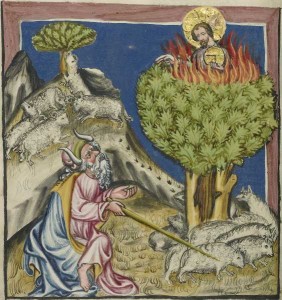
Scripture passages pointing to the Eucharist from Exodus, Leviticus, Deuteronomy and Joshua:
- Exodus 4:1-9 – Three signs
- Exodus 7:14-21 –First Plague
- The Passover
- Exodus 12:1-11 – Sacrifice of the Passover Lamb
- Exodus 12:11-14 – Marked by the Blood
- Exodus 12:15-17 – Feast of Unleavened Bread
- Manna from Heaven
- Exodus 16:2-8 – Manna in the desert
- Joshua 5:10-15 – End of the Manna
- Exodus 24:1-11 – Sprinkling of the Blood
- Exodus 25:1,8-9,23-30 – The Bread of the Presence
- Deuteronomy 6:4-12 – The Promised Land
- Leviticus 17:10-11 – Prohibition Against Drinking Blood
Exodus 4:1-9 – Three signs
“But,” objected Moses, “suppose they will not believe me, nor listen to my plea? For they may say, ‘The LORD did not appear to you.'” The LORD therefore asked him, “What is that in your hand?” “A staff,” he answered. The LORD then said, “Throw it on the ground.” When he threw it on the ground it was changed into a serpent, and Moses shied away from it. “Now, put out your hand,” the LORD said to him, “and take hold of its tail.” So he put out his hand and laid hold of it, and it became a staff in his hand. “This will take place so that they may believe,” he continued, “that the LORD, the God of their fathers, the God of Abraham, the God of Isaac, the God of Jacob, did appear to you.” Again the LORD said to him, “Put your hand in your bosom.” He put it in his bosom, and when he withdrew it, to his surprise his hand was leprous, like snow. The LORD then said, “Now, put your hand back in your bosom.” Moses put his hand back in his bosom, and when he withdrew it, to his surprise it was again like the rest of his body. “If they will not believe you, nor heed the message of the first sign, they should believe the message of the second. And if they will not believe even these two signs, nor heed your plea, take some water from the river and pour it on the dry land. The water you take from the river will become blood on the dry land.”
Throughout the Exodus, there are signs pointing to the Eucharist. God starts this with His revelation at the burning bush to Moses.
God reveals Who He is and gives some insight into His nature. He does this with three signs. These are offered evidence for the Israelites to prove who He is. Although all three are directed to identify God to the Israelites and to reveal more about Himself, they also point to the Eucharist.
The first sign is changing the staff into a serpent and then changing the serpent back into a staff. This shows God’s power over evil. The serpent represents both one of the gods of Egypt and the serpent in Genesis that tempts Adam into the first sin. By this sign, God displays His dominion and power over both the gods of Egypt and the serpent in Genesis. There is nothing that can challenge God. Adam’s sin brought several curses, but one that was felt very keenly by all people is mortality. The serpent, by tempting Adam to sin brought death into the world. God’s dominion over the serpent also includes dominion over life and death. Although not revealed yet, life will be offered to us through the Eucharist.
The second sign shows God’s power to heal and His power over sin. In the second sign, God makes Moses’ hand leprous and then heals it. Leprosy was incurable and greatly feared. By afflicting Moses with severe leprosy in his hand and then curing it, God is showing He can heal anything. Additionally, afflictions such as leprosy were believed to be punishments for sin. The affliction and healing show that God can enact justice, punishing sin immediately and severely, and He can show mercy, forgiving and healing the person of the sin. The mercy of God is given to us in several of the Sacraments, but the pinnacle of this is the reception of God Himself in the Eucharist.
The final sign ties all of this together and connects directly to Eucharist. The third sign changes water into blood. God is conveying that He has power over life. Life is in the blood, so changing water to blood is a sign that God can bring forth life. God is the creator. He can create life from where no life existed before. In this sign, we see the two stage revelation of the Eucharist by Christ. At the start of His public ministry, He changes water into wine in Cana. At the end of His public ministry at the Last Supper, He changes wine into His Most Precious Blood.
God gives the three signs so that the Israelites may believe. They are signs to aid their faith. The Eucharist is the ultimate sign to strengthen our faith. On one hand, believing the bread and wine are truly changed into the body and blood is virtually impossible to accept – our senses cannot perceive Jesus in the bread and wine. On the other hand, the reality is that the Eucharist is truly Jesus fully present to us. With it, we are given the life of Jesus to live within us and to fortify our faith. So, without the Eucharist (and Jesus) we could never accept this, but with it, we have more grace than we could ever need!
Exodus 7:14-21 –First Plague
Then the LORD said to Moses, “Pharaoh is obdurate in refusing to let the people go. Tomorrow morning, when he sets out for the water, go and present yourself by the river bank, holding in your hand the staff that turned into a serpent. Say to him: The LORD, the God of the Hebrews, sent me to you with the message: Let my people go to worship me in the desert. But as yet you have not listened. The LORD now says: This is how you shall know that I am the LORD. I will strike the water of the river with the staff I hold, and it shall be changed into blood. The fish in the river shall die, and the river itself shall become so polluted that the Egyptians will be unable to drink its water.” The LORD then said to Moses, “Say to Aaron: Take your staff and stretch out your hand over the waters of Egypt – their streams and canals and pools, all their supplies of water – that they may become blood. Throughout the land of Egypt there shall be blood, even in the wooden pails and stone jars.” Moses and Aaron did as the LORD had commanded. Aaron raised his staff and struck the waters of the river in full view of Pharaoh and his servants, and all the water of the river was changed into blood. The fish in the river died, and the river itself became so polluted that the Egyptians could not drink its water. There was blood throughout the land of Egypt.
With the first plague, God works to reveal His dominion and power while providing more hints at the ultimate plan to give us Himself in the Eucharist. When Moses first appeals to Pharaoh, Moses asks for a few days for the Israelites to worship. The request is not for total liberation. God wants the Israelites to properly order their lives, worshiping God first and above all else.
It is only when Pharaoh refuses Moses’ request that the demand changes to total freedom and exodus from Egypt. This change is necessary if the Israelites are going to worship God properly. They cannot be under Pharaoh’s dominion and serve God above everything else.
The first plague points directly to God being the source of life. The Nile made life in Egypt possible. Egypt is a desert, and without the water of the Nile, no one could survive there. The importance of the Nile led to the worship of the Nile as a god in Egypt. It was seen as the bringer of water, necessary for life, and of fertility. The first plague seeks to overturn this. It is God alone who creates and sustains life. By turning the Nile to blood, God shows that He has dominion over life. Additionally, the gods of Egypt can do nothing to stop this. The plague demonstrates the inferiority of the gods of Egypt before God.
Similar to the third sign to Moses, the first plague previews the first and last signs of Jesus in His ministry. He starts with turning water into wine and finishes with turning wine into His blood. This also models our path in the Church. We start our initiation with the waters of Baptism and conclude by receiving the blood of Christ in the Eucharist.
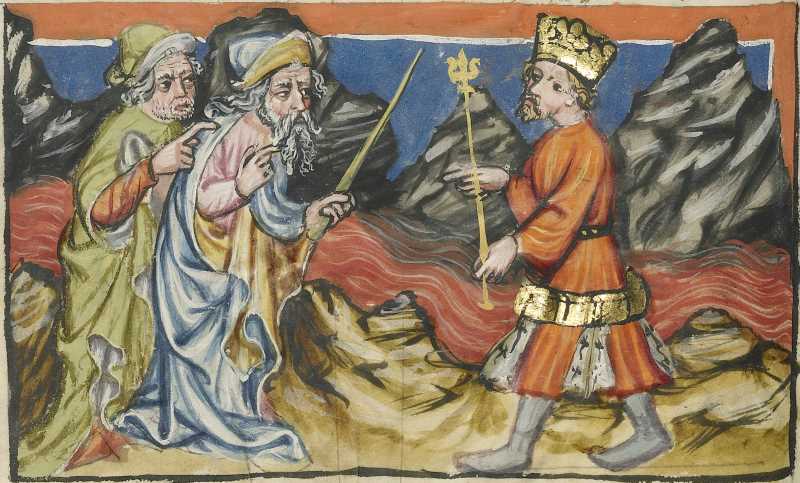
The Passover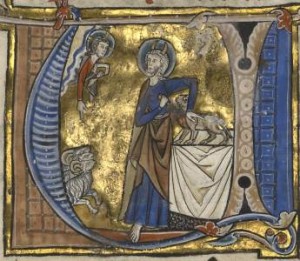
The Passover is a defining moment for Israel. It is the fulfillment of God’s promise to deliver them from four hundred years of slavery made to Abraham long before they were enslaved. After those 400 years, they were delivered. Theologically, a discussion of the Passover could (and does) fill books. Our focus is on the Eucharist and how the Passover prefigures the ultimate gift of love by the Lamb of God. To do that, we will look at the Passover in three parts.
Exodus 12:1-11 – Sacrifice of the Passover Lamb
The LORD said to Moses and Aaron in the land of Egypt, “”This month shall stand at the head of your calendar; you shall reckon it the first month of the year. Tell the whole community of Israel: On the tenth of this month every one of your families must procure for itself a lamb, one apiece for each household. If a family is too small for a whole lamb, it shall join the nearest household in procuring one and shall share in the lamb in proportion to the number of persons who partake of it. The lamb must be a year-old male and without blemish. You may take it from either the sheep or the goats. You shall keep it until the fourteenth day of this month, and then, with the whole assembly of Israel present, it shall be slaughtered during the evening twilight. They shall take some of its blood and apply it to the two doorposts and the lintel of every house in which they partake of the lamb. That same night they shall eat its roasted flesh with unleavened bread and bitter herbs. It shall not be eaten raw or boiled, but roasted whole, with its head and shanks and inner organs. None of it must be kept beyond the next morning; whatever is left over in the morning shall be burned up. “This is how you are to eat it: with your loins girt, sandals on your feet and your staff in hand, you shall eat like those who are in flight. It is the Passover of the LORD.
The Passover is one of the greatest signs in the Old Testament pointing to the Eucharist. The Israelites are commanded to sacrifice a lamb. It is not enough that they kill a lamb. They must eat its flesh. Likewise, it is not enough that Jesus, the Lamb of God, died on the cross. We must participate in His sacrifice by eating His flesh in the Holy Eucharist.
Exodus 12:11-14 – Marked by the Blood
It is the Passover of the LORD. For on this same night I will go through Egypt, striking down every first – born of the land, both man and beast, and executing judgment on all the gods of Egypt-I, the LORD! But the blood will mark the houses where you are. Seeing the blood, I will pass over you; thus, when I strike the land of Egypt, no destructive blow will come upon you. “This day shall be a memorial feast for you, which all your generations shall celebrate with pilgrimage to the LORD, as a perpetual institution.”
Eating the lamb is critical, but this is still not enough. The Israelites are commanded to mark their houses with the blood of the lamb. This practice forces the Israelites to take a stand. They know that sacrificing a lamb, worshiped by the Egyptians, is against the law. Marking their houses means they will be easily identified by the Egyptians the next day. They must trust in God to protect them. God uses this to identify the Israelites as well, and protects them from death in the 10th plague. We are protected from death when we make our pilgrimage to the Lord, receiving His body and blood, and marking us with the blood of the Lamb.
Exodus 12:15-17 – Feast of Unleavened Bread
For seven days you must eat unleavened bread. From the very first day you shall have your houses clear of all leaven. Whoever eats leavened bread from the first day to the seventh shall be cut off from Israel. On the first day you shall hold a sacred assembly, and likewise on the seventh. On these days you shall not do any sort of work, except to prepare the food that everyone needs. “Keep, then, this custom of the unleavened bread. Since it was on this very day that I brought your ranks out of the land of Egypt, you must celebrate this day throughout your generations as a perpetual institution.
The lamb and the blood of the lamb are at the heart of the Passover, but one other element is critically important. God commands that they eat unleavened bread for seven days. This, like the rest of the Passover, is set as a perpetual institution. With the three elements, the sacrificial lamb whose flesh must be eaten, the blood of the lamb marking the Israelites, and the unleavened bread, we have a prototype for the Pascal Sacrifice and the Eucharist.
Manna From Heaven
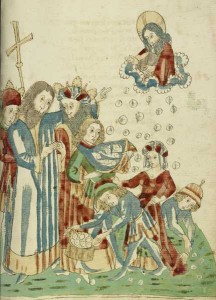 The manna from heaven is a truly spectacular miracle. It is important to remember that everything in the Old Testament is just a sign pointing to New Testament. Jesus is the fulfillment of every prophecy. As amazing as the miracles of the Old Testament are, Jesus’ realization of God’s promises is far more spectacular than the signs pointing to Him.
The manna from heaven is a truly spectacular miracle. It is important to remember that everything in the Old Testament is just a sign pointing to New Testament. Jesus is the fulfillment of every prophecy. As amazing as the miracles of the Old Testament are, Jesus’ realization of God’s promises is far more spectacular than the signs pointing to Him.
Exodus 16:2-8
Here in the desert the whole Israelite community grumbled against Moses and Aaron. The Israelites said to them, “Would that we had died at the LORD’S hand in the land of Egypt, as we sat by our fleshpots and ate our fill of bread! But you had to lead us into this desert to make the whole community die of famine!” Then the LORD said to Moses, “I will now rain down bread from heaven for you. Each day the people are to go out and gather their daily portion; thus will I test them, to see whether they follow my instructions or not. On the sixth day, however, when they prepare what they bring in, let it be twice as much as they gather on the other days.”
For forty years, the Israelites had to trust in God. They couldn’t stockpile any food, and started each day with nothing. They lived by the bread that rained down from heaven. This is even more true for the Eucharist. We may not need it to sustain our bodies, but we need the Bread of Life to sustain our souls. Without body and blood of our Lord, we have no life within us (Jn 6:53).
Joshua 5:10-15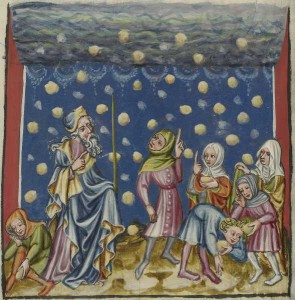
While the Israelites were encamped at Gilgal on the plains of Jericho, they celebrated the Passover on the evening of the fourteenth of the month. On the day after the Passover they ate of the produce of the land in the form of unleavened cakes and parched grain. On that same day after the Passover on which they ate of the produce of the land, the manna ceased. No longer was there manna for the Israelites, who that year ate of the yield of the land of Canaan. While Joshua was near Jericho, he raised his eyes and saw one who stood facing him, drawn sword in hand. Joshua went up to him and asked, “Are you one of us or of our enemies?” He replied, “Neither. I am the captain of the host of the LORD and I have just arrived.” Then Joshua fell prostrate to the ground in worship, and said to him, “What has my lord to say to his servant?” The captain of the host of the LORD replied to Joshua, “Remove your sandals from your feet, for the place on which you are standing is holy.” And Joshua obeyed.
The manna continued for forty years. When it ended, it was the day after the Passover, reminding us that that manna was the food provided as part of the Israelites’ the deliverance from slavery. When the manna ceased, an angel appeared with sword drawn. This is reminiscent of the angels guarding the way back to the garden and tree of life. If the tree of life is protected by two cherubim and the end of the manna is marked by the appearance of the captain of the host of the Lord, how much must the Eucharist be reverenced and protected by the angels in heaven? It is only through God’s grace and infinite love that we can approach the Most Blessed Sacrament.
Exodus 24:1-11 – Sprinkling of the Blood
Moses himself was told, “Come up to the LORD, you and Aaron, with Nadab, Abihu, and seventy of the elders of Israel. You shall all worship at some distance, but Moses alone is to come close to the LORD; the others shall not come too near, and the people shall not come up at all with Moses.” When Moses came to the people and related all the words and ordinances of the LORD, they all answered with one voice, “We will do everything that the LORD has told us.” Moses then wrote down all the words of the LORD and, rising early the next day, he erected at the foot of the mountain an altar and twelve pillars for the twelve tribes of Israel. Then, having sent certain young men of the Israelites to offer holocausts and sacrifice young bulls as peace offerings to the LORD, Moses took half of the blood and put it in large bowls; the other half he splashed on the altar. Taking the book of the covenant, he read it aloud to the people, who answered, “All that the LORD has said, we will heed and do.” Then he took the blood and sprinkled it on the people, saying, “This is the blood of the covenant which the LORD has made with you in accordance with all these words of his.” Moses then went up with Aaron, Nadab, Abihu, and seventy elders of Israel, and they beheld the God of Israel. Under his feet there appeared to be sapphire tilework, as clear as the sky itself. Yet he did not smite these chosen Israelites. After gazing on God, they could still eat and drink.
After sacrifices to the Lord, Moses takes the blood of the sacrifices and splashes half of it on the altar. He sprinkled the rest of the blood on the people. This was a visible sign of the covenant between the people of Israel and God. This points to the blood of the new covenant. We must encounter the blood of Christ to enter into His covenant. Instead of having the blood sprinkled on us, we are called to a more intimate union. We must drink His blood. The blood of the sacrificed bulls would be washed away from the Israelites’ skin, but once we receive the blood of Christ and it enters into us, we cannot separate His blood from ours.
Exodus 25:1,8-9,23-30 – The Bread of the Presence
This is what the LORD then said to Moses: “They shall make a sanctuary for me, that I may dwell in their midst. This Dwelling and all its furnishings you shall make exactly according to the pattern that I will now show you. “You shall also make a table of acacia wood, two cubits long, a cubit wide, and a cubit and a half high. Plate it with pure gold and make a molding of gold around it. Surround it with a frame, a handbreadth high, with a molding of gold around the frame. You shall also make four rings of gold for it and fasten them at the four corners, one at each leg, on two opposite sides of the frame as holders for the poles to carry the table. These poles for carrying the table you shall make of acacia wood and plate with gold. Of pure gold you shall make its plates and cups, as well as its pitchers and bowls for pouring libations. On the table you shall always keep showbread set before me.”
God gives very clear and specific instructions for the Tabernacle. This is the place where God will be present to His people, and its design reflects the significance of its purpose. The Tabernacle is a picture of heaven and is a physical tangible sign of God’s invisible but very real presence.
We see this fulfilled in the Mass. At every Mass, we are not just in a place with God. Instead, we participate in the heavenly liturgy where God is worshipped. We read in Revelation how the New Jerusalem descends and unites with earth. This happens at every Mass. We only see the physical elements on earth, but unseen heaven descends to be present. The signs in the Mass are there so we can see past the physical world and know that while we are still on earth, we are united with God and heaven for a brief time in worship.
The altar, candles, bread from heaven, vestments, and many other details are first revealed in the Old Testament, fulfilled in the New Testament, and eternally reside in heaven.
God commands that 12 loaves of bread be placed before Him in the Tabernacle. This is an image of the Tabernacle to come. Today, in every Catholic Church, the Tabernacle contains the Blessed Sacrament which is the body of Christ under the appearance of bread.
The description of the Tabernacle hints at the mystery of the Trinity. We believe in One God, but three Persons, the Father, the Son and the Holy Spirit. How God can be both One and Three is something we can’t comprehend. A variety of analogies have been suggested, but all fall short of reality (and a few are misleading).
God requires three elements to be placed in the Tabernacle. The first is the arc of the covenant, containing the ten commandments, the staff of Aaron, and some of the manna. The arc had the mercy seat where God would sit when He was present. This is an image of God the Father. The next item in the Tabernacle was the menorah. The flames of the candles in the menorah are an image of the Holy Spirit. Finally, we have a table with the bread of the presence. Twelve loaves of bread, with wine, are commanded to be placed continually in the holy of holies with the arc and menorah. The bread and wine are images of Jesus in the Eucharist. All three, Father, Son, and Holy Spirit were present, even though the mystery of the Trinity had not yet been revealed.
Deuteronomy 6:4-12 – The Promised Land
Hear, O Israel! The LORD is our God, the LORD alone! Therefore, you shall love the LORD, your God, with all your heart, and with all your soul, and with all your strength. Take to heart these words which I enjoin on you today. Drill them into your children. Speak of them at home and abroad, whether you are busy or at rest. Bind them at your wrist as a sign and let them be as a pendant on your forehead. Write them on the doorposts of your houses and on your gates. When the LORD, your God, brings you into the land which he swore to your fathers, Abraham, Isaac and Jacob, that he would give you, a land with fine, large cities that you did not build, with houses full of goods of all sorts that you did not garner, with cisterns that you did not dig, with vineyards and olive groves that you did not plant; and when, therefore, you eat your fill, take care not to forget the LORD, who brought you out of the land of Egypt, that place of slavery.
God commands that we love Him and display our love in everything we say and do. In the promised land, God promises an abundance, including great food. We will eat our fill. God is promising to feed us, but ordinary food can never fill us. Our hunger will always return, and nothing but God can ever satisfy our hearts. The promise that we will eat our fill is only fulfilled in the Eucharist, when we feed on the body, blood, soul and divinity of Jesus, our Lord. Only the infinite love of God can truly fill us.
Leviticus 17:10-11 – Prohibition Against Drinking Blood
And if anyone, whether of the house of Israel or of the aliens residing among them, partakes of any blood, I will set myself against that one who partakes of blood and will cut him off from among his people. Since the life of a living body is in its blood, I have made you put it on the altar, so that atonement may thereby be made for your own lives, because it is the blood, as the seat of life, that makes atonement.
God commands that no one ever drink blood. This seems to be a direct refutation against the Eucharist. Why would Jesus, who knew the law better than anyone, command us to drink His blood if the law prohibits the drinking of blood? The key is understanding where our life comes from. Our life is from God. Life is in the blood, but we cannot take life from animals or other people. Meat might sustain my body, but it cannot provide life to me. We receive life only from God. The prohibition against drinking blood is a prohibition against our trying to take life from others. It is in the blood, the blood of Christ, that we will receive abundant and eternal life.
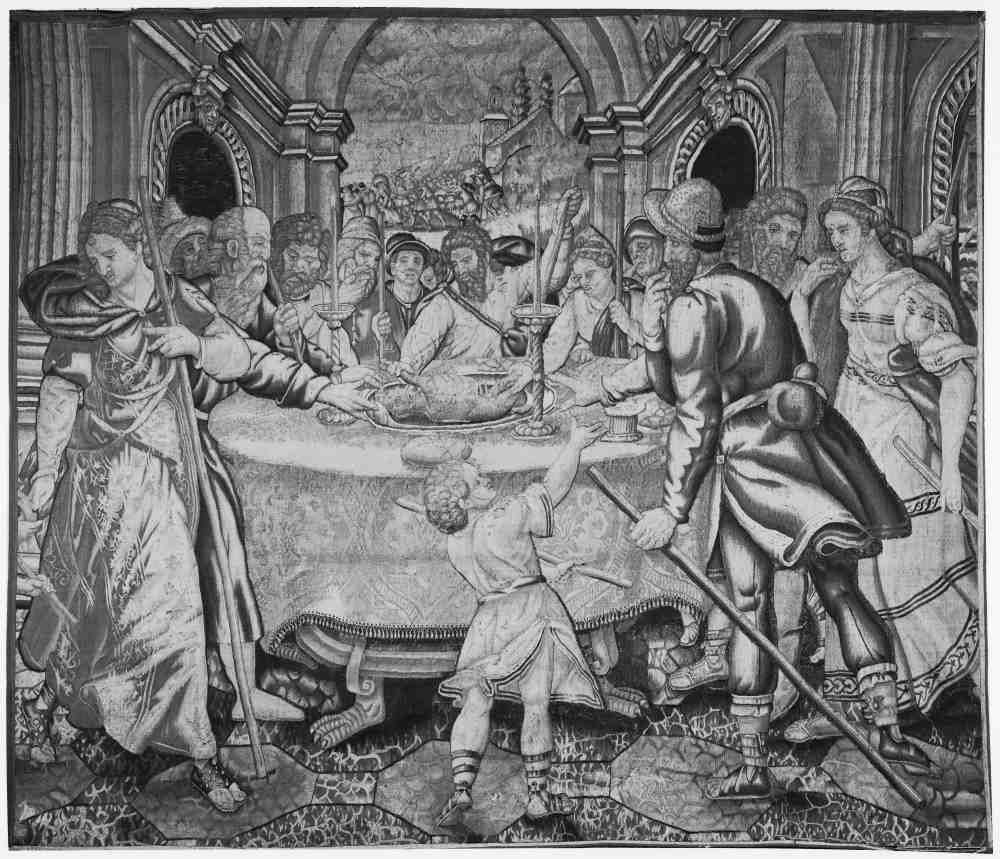
Images:
Unknown, Moses and the Burning Bush, about 1400 – 1410, Tempera colors, gold, silver paint, and ink on parchment, Leaf: 33.5 x 23.5 cm (13 3/16 x 9 1/4 in.), The J. Paul Getty Museum, Los Angeles
Unknown, Moses Changing the Water of the Nile into Blood, about 1400 – 1410, Tempera colors, gold, silver paint, and ink on parchment, Leaf: 33.5 x 23.5 cm (13 3/16 x 9 1/4 in.), The J. Paul Getty Museum, Los Angeles
Unknown, Initial V: Moses Sacrificing a Lamb, about 1260 – 1270, Tempera colors, gold leaf, and red ink on parchment, Leaf: 48.9 x 35.4 cm (19 1/4 x 13 15/16 in.), The J. Paul Getty Museum, Los Angeles
Follower of Hans Schilling (German, active 1459 – 1467), from the Workshop of Diebold Lauber (German, active 1427 – 1467), King Avenir, Josaphat, and Nachor Behold Hour Manna Fell in the Desert, 1469, Ink, colored washes, and tempera colors on paper, Leaf: 28.6 x 20.3 cm (11 1/4 x 8 in.)
The J. Paul Getty Museum, Los Angeles
Unknown, The Israelites Collecting Manna from Heaven, about 1400 – 1410, Tempera colors, gold, silver paint, and ink on parchment, Leaf: 33.5 x 23.5 cm (13 3/16 x 9 1/4 in.), The J. Paul Getty Museum, Los Angeles
Unknown, Celebration of first Passover, 1600-1700, Tapestry Dimensions: H 9’9″ x W 13’5″, The Getty Research Institute, Los Angeles.